Vodafone UK is operating live open radio access network (open RAN) technology in the towns of Torquay and Exter in England. It refers to these open RAN sites as “Golden Clusters” — not a name that probably would have been chosen in the U.S.
Nevertheless, Vodafone UK is very pleased with the progress it’s made at the Golden Cluster sites. And yesterday at the Telecom Infra Project (TIP) event in Madrid, Spain, Andrea Dona, chief network officer with Vodafone UK, provided an update.
He said Vodafone has deployed 22 sites at the two locations to really test open RAN technology in a brownfield, urban environment. And it’s in the process of deploying seven more sites by the end of this month.
All of this has been supported by the U.K. government as part of its effort to remove Huawei equipment from networks and support open RAN technology.
Dona called the Golden Cluster sites “a breakthrough moment” for open RAN. The sites were delivered in a brownfield network to towns with populations of 33,000 and 60,000. “And it’s cross-functional and cross-vendor,” he said. “There was a lot of skepticism whether we could do that. Could you truly bring together such disparate vendors?”

He said the project “triggers a different way of working among the various partners, ensuring no one is defensive about something not working but actually truly collaborative in trying to fix it and optimize it.”
In addition, he said the technology is working well for customers, according to key performance indicators. “Ninety percent of all the KPIs are either the same or better than the legacy kit we’re swapping out,” said Dona. “I’m confident with the latest software releases from our partners we will close those gaps.”
At yesterday’s TIP event Vodafone Director of Network Architecture Santiago Tenorio said Vodafone U.K. is on track with its goal to deploy 2,500 open RAN sites. “That is the volume rollout that starts now,” he said.
The next work in the U.K. will be to integrate third-party massive MIMO from NEC. “It’s in the lab, and we expect that before Mobile World Congress,” Tenorio said. “It’s important because it demonstrates the openness of the interface, and it demonstrates that third-party radio integrated into someone else’s software. And we decided to start with massive MIMO because it is the most difficult part.”
Dona said the open RAN work in the U.K. is a “blueprint for success” and that Vodafone can “lift and shift” it to other parts of its global footprint.
Other Vodafone open RAN work
Tenorio also updated the TIP audience on other Vodafone work related to open RAN.
He said the operator will issue a request for quotes for open RAN technology across its entire global footprint, which is 170,000 sites of which more than 100,000 are in Europe. “It’s probably one of the biggest RFQs the industry has seen for a while,” he said. “We expect 30% of the footprint to go in the direction of open RAN, which is out of that tender. Many suppliers now have open RAN on their roadmap. We’re going to use this RFQ to improve their commitment, to improve their specification, to drive everybody in the industry to commit what we think open RAN should be doing.”
In other news, Vodafone and Nokia announced plans to run a commercial 5G open RAN pilot in Italy for the first time. Covering a cluster of sites in northern Italy, the pilot will involve Nokia containerized baseband software running on Red Hat OpenShift, hosted on Dell PowerEdge XR8000 servers.
The pilot will be on Vodafone’s 5G standalone network. “We will have it in the lab before the end of this calendar year. And we are aiming to have it in the field in the first quarter of 2024,” said Tenorio.
Finally, Vodafone and Orange announced they conducted live 4G calls over a cluster of shared commercial network sites in a rural area near Bucharest, Romania, based on open RAN technology, with Samsung as the vendor.
Of the Romanian pilot, Tenorio said, “The stack that we have there is the same as the one we have in the U.K. So we are using everything we learned in the U.K.”
But he said what’s unique is that the cluster of 10 sites includes five from Vodafone and five from Orange. “Our aim is to be providing similar service to the customer when they’re going to be moving from one site to another and maybe one is Vodafone and one is Orange,” he said. “That is the first step in the direction of something that only open RAN can actually enable, which is to have a common set of infrastructure with software from different vendors running in different containers. We’re not there yet, but we have the first 4G call live.”